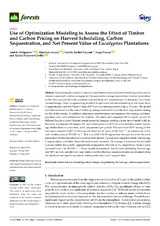Use of Optimization Modeling to Assess the Effect of Timber and Carbon Pricing on Harvest Scheduling, Carbon Sequestration, and Net Present Value of Eucalyptus Plantations
Autor
Hirigoyen, Andrés
Acuna, Mauricio
Rachid-Casnati, Cecilia
Franco, Jorge
Navarro Cerrillo, Rafael M.
Editor
MDPIFecha
2021Materia
Timber harvest schedulingMixed-integer programming
Harvest age
Carbon sequestration
METS:
Mostrar el registro METSPREMIS:
Mostrar el registro PREMISMetadatos
Mostrar el registro completo del ítemResumen
Quantifying the impact of carbon (C) and timber prices on harvest scheduling and economic returns is essential to define strategies for the sustainable management of short-rotation plantations so that they can provide timber products and contribute to C sequestration. In this paper, we present a mixed-integer linear programming model that optimizes harvest scheduling at the forest level, C sequestration, and Net Present Value (NPV) over a planning period of up to 15 years. The model included revenue from the sale of timber (pulplogs) and credits from the net C sequestered during the life of the stands. In addition, plantation establishment, management, harvesting, and transportation costs were included in the analysis. The study area comprised 88 Eucalyptus grandis W. Hill and Eucalyptus dunnii Maiden stands located in Uruguay, totaling a forest area of nearly 1,882 ha. The study investigated the impact of C and timber prices on NPV, harvest schedules, stands’ harvest age, timber flows to customers, and C sequestered per period. The maximum NPV among all the scenarios evaluated (USD 7.53 M) was calculated for a C price of 30 USD t−1, an interest rate of 6%, and a timber price of 75 USD m−3. This was USD 2.14 M higher than the scenario with the same parameters but that included only revenue from timber. C prices also impacted stands’ harvest age, C sequestration, and timber flows delivered to end customers. On average, in scenarios that included C prices, timber flows and C sequestration increased by 15.4 and 12.1%, respectively, when C price increased from 5 to 30 USD t−1. These results demonstrate that harvest scheduling, harvest age, and NPV are very sensitive to C and timber, and that the best economic returns are obtained when the stands are managed to maximize timber production and C sequestration.

